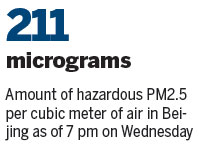

Smog will linger and worsen to hazardous levels in many northern cities, including Beijing, until Friday night, when wind will disperse the pollutants, the national environmental authority said on Wednesday.
The levels of major air pollutants climbed in Beijing since Tuesday and continued to worsen. By 7 pm on Wednesday, the peak reading of PM2.5 - particulate matter of less than 2.5 microns in diameter that is hazardous to health - reached 211 micrograms per cubic meter.
Air pollution in Beijing stood at the second-worst level, hazardous to human health, and the capital issued a yellow alert on Wednesday, the third-highest alert of the four-tier emergency response system.
The air quality will also deteriorate in many other cities in the Beijing-Tianjin-Hebei region and neighboring provinces like Shanxi and Henan until Friday, Luo Yi, head of the Environmental Monitoring Department of the Ministry of Environmental Protection, said on Wednesday.

"The pollutants in this patch of smog come mainly from local coal burning, vehicle exhaust and some companies," said Chai Fahe, deputy head of the China Research Academy of Environmental Sciences.
The annual meetings of the National Committee of the Chinese People's Political Consultative Conference and the National People's Congress are to start on Thursday and Saturday, respectively.
At the first CPPCC news conference, Wang Guoqing, spokesman for the CPPCC annual session, said China has made a series of efforts to curb air pollution in the past years, and these have reduced the number of polluted days.
But it would take time to see clear improvement, Wang said.
"Governments need to note the urgency of alleviating pollution and enact tough restrictions, but also treat curbing efforts as a long-term campaign," he said.
zhengjinran@chinadaily.com.cn